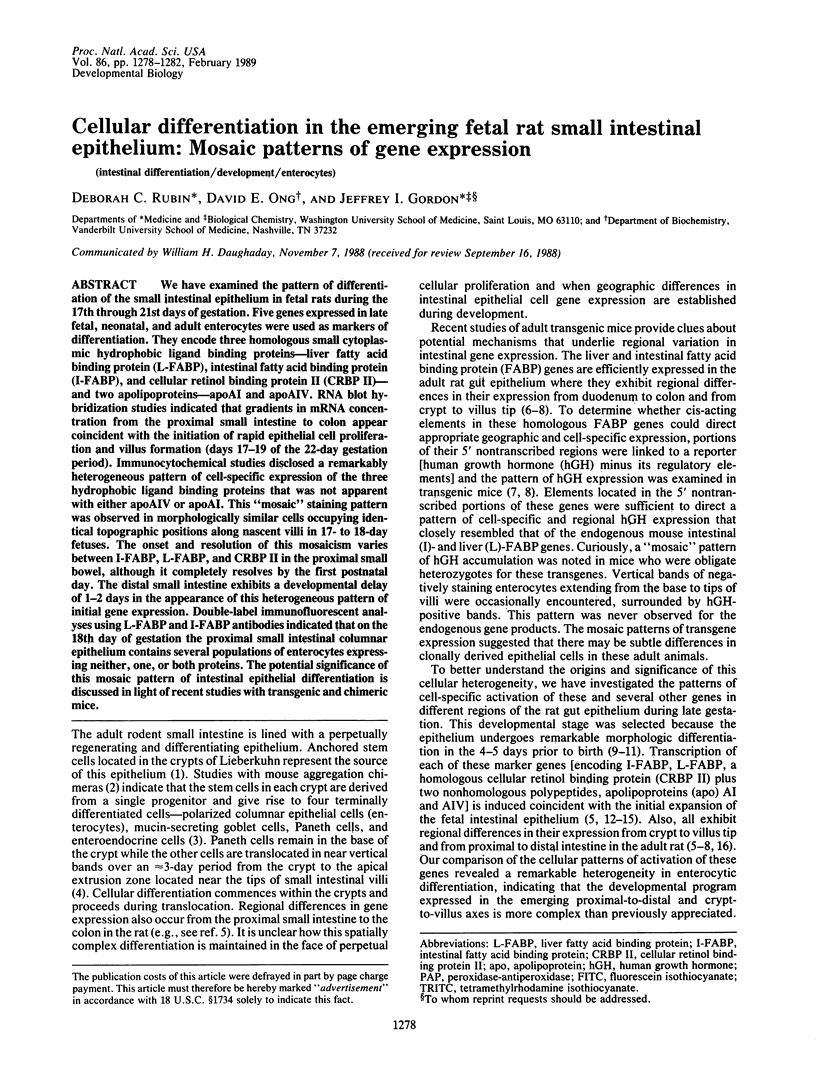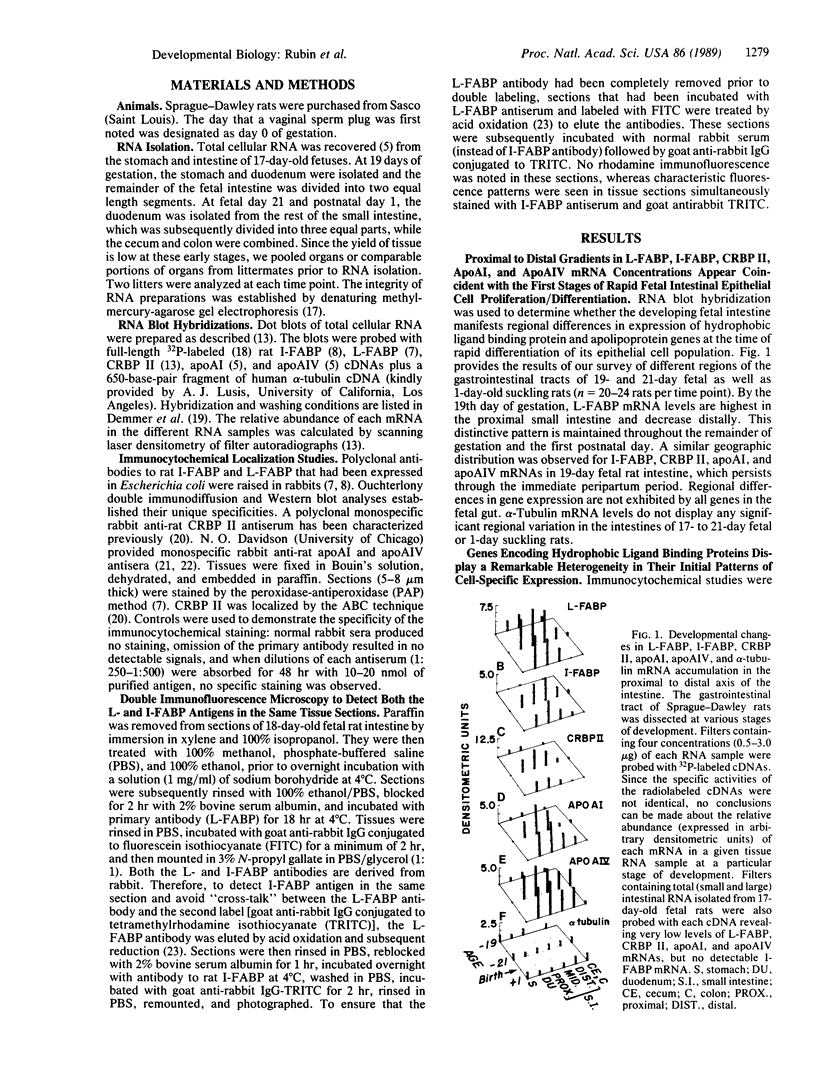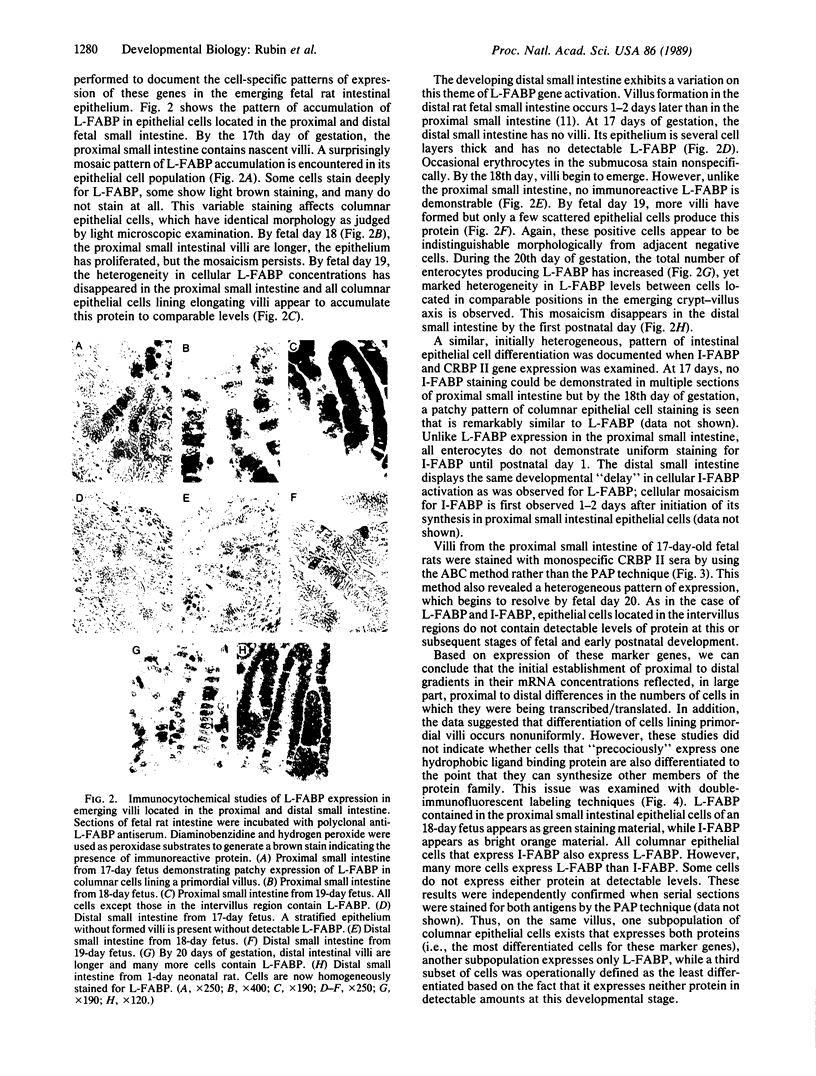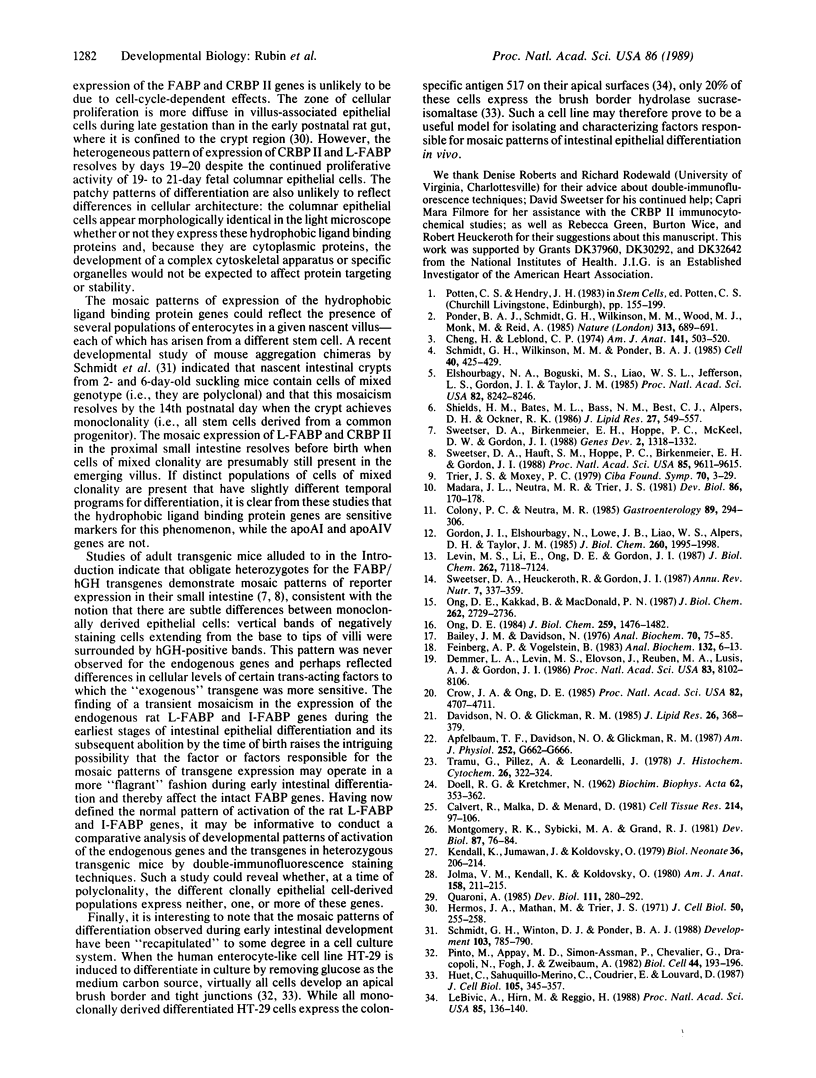Abstract
We have examined the pattern of differentiation of the small intestinal epithelium in fetal rats during the 17th through 21st days of gestation. Five genes expressed in late fetal, neonatal, and adult enterocytes were used as markers of differentiation. They encode three homologous small cytoplasmic hydrophobic ligand binding proteins--liver fatty acid binding protein (L-FABP), intestinal fatty acid binding protein (I-FABP), and cellular retinol binding protein II (CRBP II)--and two apolipoproteins--apoAI and apoAIV. RNA blot hybridization studies indicated that gradients in mRNA concentration from the proximal small intestine to colon appear coincident with the initiation of rapid epithelial cell proliferation and villus formation (days 17-19 of the 22-day gestation period). Immunocytochemical studies disclosed a remarkably heterogeneous pattern of cell-specific expression of the three hydrophobic ligand binding proteins that was not apparent with either apoAIV or apoAI. This "mosaic" staining pattern was observed in morphologically similar cells occupying identical topographic positions along nascent villi in 17- to 18-day fetuses. The onset and resolution of this mosaicism varies between I-FABP, L-FABP, and CRBP II in the proximal small bowel, although it completely resolves by the first postnatal day. The distal small intestine exhibits a developmental delay of 1-2 days in the appearance of this heterogeneous pattern of initial gene expression. Double-label immunofluorescent analyses using L-FABP and I-FABP antibodies indicated that on the 18th day of gestation the proximal small intestinal columnar epithelium contains several populations of enterocytes expressing neither, one, or both proteins. The potential significance of this mosaic pattern of intestinal epithelial differentiation is discussed in light of recent studies with transgenic and chimeric mice.
Full text
PDF




Images in this article
Selected References
These references are in PubMed. This may not be the complete list of references from this article.
- Apfelbaum T. F., Davidson N. O., Glickman R. M. Apolipoprotein A-IV synthesis in rat intestine: regulation by dietary triglyceride. Am J Physiol. 1987 May;252(5 Pt 1):G662–G666. doi: 10.1152/ajpgi.1987.252.5.G662. [DOI] [PubMed] [Google Scholar]
- Bailey J. M., Davidson N. Methylmercury as a reversible denaturing agent for agarose gel electrophoresis. Anal Biochem. 1976 Jan;70(1):75–85. doi: 10.1016/s0003-2697(76)80049-8. [DOI] [PubMed] [Google Scholar]
- Calvert R., Malka D., Ménard D. Establishment of regional differences in brush border enzymatic activities during the development of fetal mouse small intestine. Cell Tissue Res. 1981;214(1):97–106. doi: 10.1007/BF00235148. [DOI] [PubMed] [Google Scholar]
- Cheng H., Leblond C. P. Origin, differentiation and renewal of the four main epithelial cell types in the mouse small intestine. III. Entero-endocrine cells. Am J Anat. 1974 Dec;141(4):503–519. doi: 10.1002/aja.1001410405. [DOI] [PubMed] [Google Scholar]
- Colony P. C., Neutra M. R. Macromolecular transport in the fetal rat intestine. Gastroenterology. 1985 Aug;89(2):294–306. doi: 10.1016/0016-5085(85)90329-4. [DOI] [PubMed] [Google Scholar]
- Crow J. A., Ong D. E. Cell-specific immunohistochemical localization of a cellular retinol-binding protein (type two) in the small intestine of rat. Proc Natl Acad Sci U S A. 1985 Jul;82(14):4707–4711. doi: 10.1073/pnas.82.14.4707. [DOI] [PMC free article] [PubMed] [Google Scholar]
- DOELL R. G., KRETCHMER N. Studies of small intestine during development. I. Distribution and activity of beta-galactosidase. Biochim Biophys Acta. 1962 Aug 13;62:353–362. doi: 10.1016/0006-3002(62)90097-5. [DOI] [PubMed] [Google Scholar]
- Davidson N. O., Glickman R. M. Apolipoprotein A-I synthesis in rat small intestine: regulation by dietary triglyceride and biliary lipid. J Lipid Res. 1985 Mar;26(3):368–379. [PubMed] [Google Scholar]
- Demmer L. A., Levin M. S., Elovson J., Reuben M. A., Lusis A. J., Gordon J. I. Tissue-specific expression and developmental regulation of the rat apolipoprotein B gene. Proc Natl Acad Sci U S A. 1986 Nov;83(21):8102–8106. doi: 10.1073/pnas.83.21.8102. [DOI] [PMC free article] [PubMed] [Google Scholar]
- Elshourbagy N. A., Boguski M. S., Liao W. S., Jefferson L. S., Gordon J. I., Taylor J. M. Expression of rat apolipoprotein A-IV and A-I genes: mRNA induction during development and in response to glucocorticoids and insulin. Proc Natl Acad Sci U S A. 1985 Dec;82(23):8242–8246. doi: 10.1073/pnas.82.23.8242. [DOI] [PMC free article] [PubMed] [Google Scholar]
- Feinberg A. P., Vogelstein B. A technique for radiolabeling DNA restriction endonuclease fragments to high specific activity. Anal Biochem. 1983 Jul 1;132(1):6–13. doi: 10.1016/0003-2697(83)90418-9. [DOI] [PubMed] [Google Scholar]
- Gordon J. I., Elshourbagy N., Lowe J. B., Liao W. S., Alpers D. H., Taylor J. M. Tissue specific expression and developmental regulation of two genes coding for rat fatty acid binding proteins. J Biol Chem. 1985 Feb 25;260(4):1995–1998. [PubMed] [Google Scholar]
- Hermos J. A., Mathan M., Trier J. S. DNA synthesis and proliferation by villous epithelial cells in fetal rats. J Cell Biol. 1971 Jul;50(1):255–258. doi: 10.1083/jcb.50.1.255. [DOI] [PMC free article] [PubMed] [Google Scholar]
- Huet C., Sahuquillo-Merino C., Coudrier E., Louvard D. Absorptive and mucus-secreting subclones isolated from a multipotent intestinal cell line (HT-29) provide new models for cell polarity and terminal differentiation. J Cell Biol. 1987 Jul;105(1):345–357. doi: 10.1083/jcb.105.1.345. [DOI] [PMC free article] [PubMed] [Google Scholar]
- Jolma V. M., Kendall K., Koldovský O. Differences in the development of jejunum and ileum as observed in fetal rat isografts. Possible implications related to the villus size gradient. Am J Anat. 1980 Jun;158(2):211–215. doi: 10.1002/aja.1001580209. [DOI] [PubMed] [Google Scholar]
- Kendall K., Jumawan J., Koldovský O. Development of jejunoileal differences of activity of lactase, sucrase and acid beta-galactosidase in isografts of fetal rat intestine. Biol Neonate. 1979;36(3-4):206–214. doi: 10.1159/000241229. [DOI] [PubMed] [Google Scholar]
- Le Bivic A., Hirn M., Reggio H. HT-29 cells are an in vitro model for the generation of cell polarity in epithelia during embryonic differentiation. Proc Natl Acad Sci U S A. 1988 Jan;85(1):136–140. doi: 10.1073/pnas.85.1.136. [DOI] [PMC free article] [PubMed] [Google Scholar]
- Levin M. S., Li E., Ong D. E., Gordon J. I. Comparison of the tissue-specific expression and developmental regulation of two closely linked rodent genes encoding cytosolic retinol-binding proteins. J Biol Chem. 1987 May 25;262(15):7118–7124. [PubMed] [Google Scholar]
- Madara J. L., Neutra M. R., Trier J. S. Junctional complexes in fetal rat small intestine during morphogenesis. Dev Biol. 1981 Aug;86(1):170–178. doi: 10.1016/0012-1606(81)90327-4. [DOI] [PubMed] [Google Scholar]
- Montgomery R. K., Sybicki M. A., Grand R. J. Autonomous biochemical and morphological differentiation in fetal rat intestine transplanted at 17 and 20 days of gestation. Dev Biol. 1981 Oct 15;87(1):76–84. doi: 10.1016/0012-1606(81)90062-2. [DOI] [PubMed] [Google Scholar]
- Ong D. E. A novel retinol-binding protein from rat. Purification and partial characterization. J Biol Chem. 1984 Feb 10;259(3):1476–1482. [PubMed] [Google Scholar]
- Ong D. E., Kakkad B., MacDonald P. N. Acyl-CoA-independent esterification of retinol bound to cellular retinol-binding protein (type II) by microsomes from rat small intestine. J Biol Chem. 1987 Feb 25;262(6):2729–2736. [PubMed] [Google Scholar]
- Ponder B. A., Schmidt G. H., Wilkinson M. M., Wood M. J., Monk M., Reid A. Derivation of mouse intestinal crypts from single progenitor cells. Nature. 1985 Feb 21;313(6004):689–691. doi: 10.1038/313689a0. [DOI] [PubMed] [Google Scholar]
- Quaroni A. Pre- and postnatal development of differentiated functions in rat intestinal epithelial cells. Dev Biol. 1985 Oct;111(2):280–292. doi: 10.1016/0012-1606(85)90483-x. [DOI] [PubMed] [Google Scholar]
- Schmidt G. H., Wilkinson M. M., Ponder B. A. Cell migration pathway in the intestinal epithelium: an in situ marker system using mouse aggregation chimeras. Cell. 1985 Feb;40(2):425–429. doi: 10.1016/0092-8674(85)90156-4. [DOI] [PubMed] [Google Scholar]
- Schmidt G. H., Winton D. J., Ponder B. A. Development of the pattern of cell renewal in the crypt-villus unit of chimaeric mouse small intestine. Development. 1988 Aug;103(4):785–790. doi: 10.1242/dev.103.4.785. [DOI] [PubMed] [Google Scholar]
- Shields H. M., Bates M. L., Bass N. M., Best C. J., Alpers D. H., Ockner R. K. Light microscopic immunocytochemical localization of hepatic and intestinal types of fatty acid-binding proteins in rat small intestine. J Lipid Res. 1986 May;27(5):549–557. [PubMed] [Google Scholar]
- Sweetser D. A., Birkenmeier E. H., Hoppe P. C., McKeel D. W., Gordon J. I. Mechanisms underlying generation of gradients in gene expression within the intestine: an analysis using transgenic mice containing fatty acid binding protein-human growth hormone fusion genes. Genes Dev. 1988 Oct;2(10):1318–1332. doi: 10.1101/gad.2.10.1318. [DOI] [PubMed] [Google Scholar]
- Sweetser D. A., Hauft S. M., Hoppe P. C., Birkenmeier E. H., Gordon J. I. Transgenic mice containing intestinal fatty acid-binding protein-human growth hormone fusion genes exhibit correct regional and cell-specific expression of the reporter gene in their small intestine. Proc Natl Acad Sci U S A. 1988 Dec;85(24):9611–9615. doi: 10.1073/pnas.85.24.9611. [DOI] [PMC free article] [PubMed] [Google Scholar]
- Sweetser D. A., Heuckeroth R. O., Gordon J. I. The metabolic significance of mammalian fatty-acid-binding proteins: abundant proteins in search of a function. Annu Rev Nutr. 1987;7:337–359. doi: 10.1146/annurev.nu.07.070187.002005. [DOI] [PubMed] [Google Scholar]
- Tramu G., Pillez A., Leonardelli J. An efficient method of antibody elution for the successive or simultaneous localization of two antigens by immunocytochemistry. J Histochem Cytochem. 1978 Apr;26(4):322–324. doi: 10.1177/26.4.207771. [DOI] [PubMed] [Google Scholar]
- Trier J. S., Moxey P. C. Morphogenesis of the small intestine during fetal development. Ciba Found Symp. 1979 Jan 16;(70):3–29. doi: 10.1002/9780470720530.ch2. [DOI] [PubMed] [Google Scholar]






